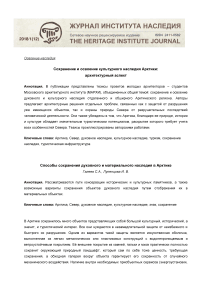Сохранение и освоение культурного наследия Арктики: архитектурный аспект
Автор: Галеев Сергей Абрекович, Лупенцов Ирина Владимировна, Белых Алексей Дмитриевич, Карташов Максим Сергеевич, Судакова Анна Евгеньевна
Журнал: Журнал института наследия @nasledie-journal
Рубрика: Освоение наследия
Статья в выпуске: 1 (12), 2018 года.
Бесплатный доступ
В публикации представлены тезисы проектов молодых архитекторов - студентов Московского архитектурного института (МАРХИ), объединенных общей темой: сохранение и освоение духовного и культурного наследия отдаленного и обширного Арктического региона. Авторы предлагают архитектурные решения отдельных проблем, связанных как с защитой от разрушения уже имеющихся объектов, так и охраны природы Севера от разрушительных последствий человеческой деятельности. Они также убеждены в том, что Арктика, благодаря ее природе, истории и культуре обладает значительным туристическим потенциалом, раскрытие которого требует учета всех особенностей Севера. Тезисы проиллюстрированы авторскими работами.
Арктика, север, духовное наследие, культурное наследие, туризм, сохранение наследия, туристическая инфраструктура, сеть туристических объектов, знак, сохранение, безопасность, климат, инфраструктура, сотрудничество
Короткий адрес: https://sciup.org/170173273
IDR: 170173273
Текст научной статьи Сохранение и освоение культурного наследия Арктики: архитектурный аспект
Освоение и развитие Арктического региона, как правило, связано с высокой мобильностью всех видов активностей: геологоразведочной, научной, туристической, промысловой и мониторинговой.
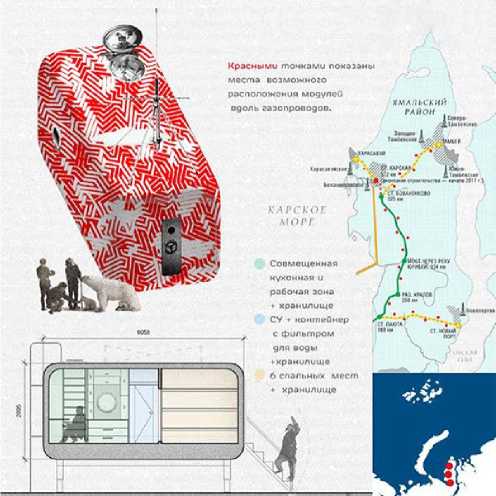
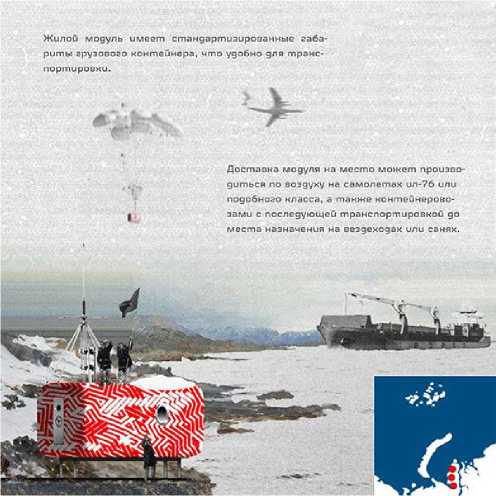
Такая мобильность, проходящая в экстремальных условиях внешней среды, делает задачу обеспечения безопасности людей одной из важнейших. Предлагаемое решение этой задачи состоит в организации сети стационарных модульных убежищ вдоль основных существующих и перспективных маршрутов передвижений, дорог, нефтепроводов и других линейных объектов. Единичный модуль этой сети представляет собой утепленный, легкий контейнер с элементами энергообеспечения, аварийным запасом воды, одежды, еды и медикаментов. В случае внезапного изменения погодных условий, травмы или других форсмажорных обстоятельств такой модуль сможет обеспечить необходимое временное убежище группе нуждающихся в помощи людей. В «спящем» режиме такой модуль может существовать годами. Такое решение для Арктике не ново, а является продолжением и развитием многовекового опыта освоения Севера: и первооткрывателями, и поморами, и современными промысловиками, и коренных народами.
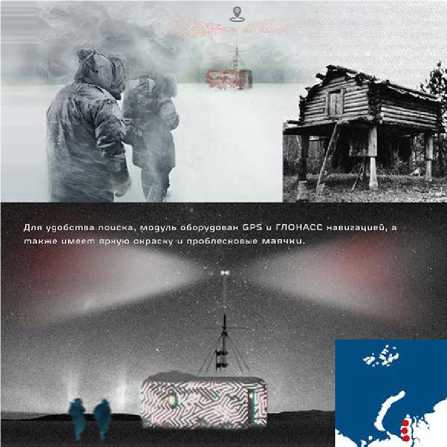
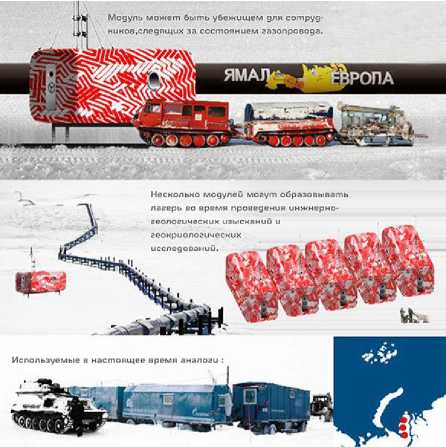
Центр международного сотрудничества на Земле Франца-Иосифа
Галеев С.А., Карташов М. С.
Потепление климата - потепление отношений. Международное сотрудничество - это основной способ сосуществования стран с разными интересами и возможностями, которое всегда находит свое отражение и в архитектуре. Почему в Арктике? Потому что в последние годы этот самый динамично развивающийся, как в экономическом, так и в климатическом отношении, регион планеты стал центром сосредоточения и геополитических, и экономических, и социальных притязаний, и как правило, разнонаправленных интересов. Почему на Земле Франца Иосифа? Потому что этот исторически самый молодой архипелаг Арктики уже с самого начала изначально возник как результат часто героических усилий первооткрывателей из многих европейских стран. Почему на острове Александры? Потому что это самый западный из острова архипелага, и соответственно, находится ближе всех к европейским государствам больше всех заинтересованным в освоении и развитии Региона, кстати, теперь уже практически полностью освободившийся от ледникового покрова. Потепление климата - потепление отношений основным участникам открытия, освоения и использования Арктики. Проектное предложение центра представляет собой развивающуюся -растущую во времени - пространственную структуру, со стационарными, как ствол у дерева и мобильными, как листья, элементами. Предусмотрено их развитие в научной, культурной и туристической сферах.
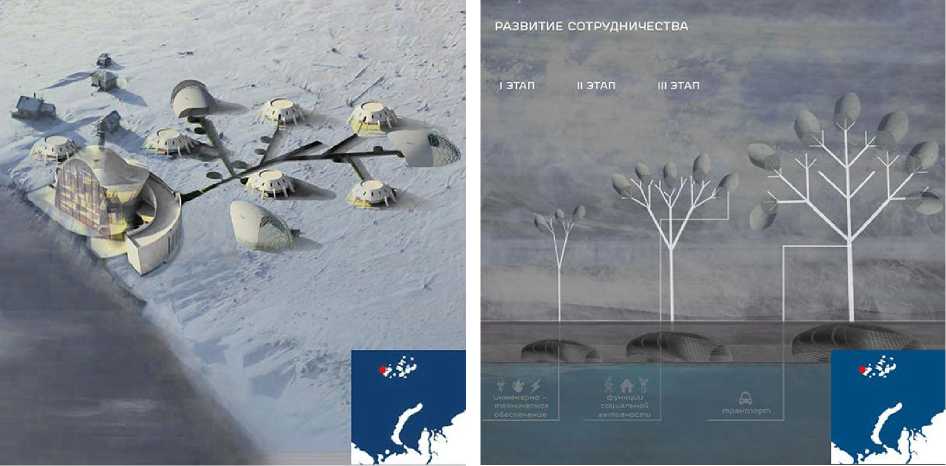
Галеев Сергей Абрекович, кандидат архитектуры, Московский архитектурный институт (Москва).
Лупенцова Ирина Владимировна,
Spiritual and material heritage: the ways of conservation
Galeev S., Lupentsova I.
In the Arctic region, there are a number of preserved objects that represent a great cultural, historical, and therefore, tourist interest. All of them need immediate protection against the inevitable and rapid destruction. One of the options for such protection is an artificial shell, made of light metal or plastic structures with a waterproof and windproof coating. Its outer covering of stones, pebbles and mosses will almost completely preserve the surrounding natural landscape, which in itself is a value worth preserving; a bypass gallery around the facility guarantees its safety from accidental mechanical impact. The presence within the necessary on-site services (power generators, RS warehouse and a lavatory) will increase the safety of the tourist route and will contribute to the development of Arctic tourism.
The section on the preservation of the spiritual heritage, is perhaps the most difficult, especially for the architect. After all, the task here is to find ways to materialize non- material phenomena. For an architect whose tool is space, there remains a specific place, a point connected with real spiritual experience. So, what can an architect do? He can dare to take the place of the one who has acquired this spiritual experience, and try to re-experience it, and then display it in spatial, material forms. From the practical point of view, from the point of view of making practical decisions, it seems to me the most correct and promising is the mapping (fixation) of such places by means of erection, installation of a «sign». The «sign» as such by definition does not have its own content - it only points to it. He refers, recalls, implies that very original spiritual experience found in this place. Such a decision is not something new and innovative - no, it revives the tradition of setting such «signs» on important, significant places known even in the Paleolithic era, dolmens and menhirs (also a legacy). Such an «object-sign» is not necessarily a single (lonely) structure, it can also represent a series of them. and even, a whole field. The size and shape of such a «sign-object» can, or rather should be determined by the unique characteristics of the environment and the scale of the event, the phenomenon that established the status of the heritage behind it. Today, material for such a «sign» can serve not only traditional stone or wooden structures, but also, for example, light or audio, video holographic installations.
Arctic objects of tourism network in the western sector of the Arctic
Galeev S., Sudakova A.
A full and effective development of the Arctic region is realized not only through the development of new resources and the creation of new ones, but also through the preservation of existing objects of the natural, cultural and spiritual heritage. These objects can serve as the basis for the development of Arctic tourism. This project proposal is aimed to solve the problems of forming the tourism infrastructure. Its essence is to create a unified network of tourist routes (in this case local - in the area of Vaigach Island) and objects of its maintenance (functioning) - an analogue of tourist bases. It is proposed to create a mobile complex based on a ship of ice class equipped with a boat and a helicopter for disembarkation of a group of tourists directly to the beginning of their route. In addition to the usual functions for the campsite, various socially significant and transport functions will also be represented there. One such complex will be able to ensure the functioning of a variety of cognitive, sporting and ecological routes on a fairly large territory of the coast and a number of arctic islands. It is envisioned that such a complex will operate not only during the summer term of the tourist season, but also throughout the year due to its mobility and diversity of functions.
Christian temple on the arctic islands
Galeev S., Kartashov M.
From the very beginning of the development of the Arctic with its extreme conditions and high risks in all respects, it was clear that without support from above it was not possible. Therefore, almost every arctic settlement erected temples or their sign elements. In the Neolithic times, they were dolmens, figures of idols (gods). Then, in the Middle Ages, Christian churches and vassal crosses were built. Of course, technological progress has greatly facilitated the lives of people in the Arctic, but almost did not reduce the risks, the main of which is to remain alone with the elements without Divine support. These reasons also served as the basis for this architectural proposal of the Christian church. According to its designs and materials, it is, of course, modern, but at the same time, in its architectural image, it is similar to the numerous wooden churches of Northern Russian architecture.
Safety of development and operation: hideouts along the arctic routes
Galeev S., Belikh A.
The development and exploration of the Arctic region, as a rule, is associated with the high mobility of all types of activities: geological exploration, scientific, tourism, fishing and monitoring. Such mobility, taking place in the extreme conditions of the external environment, makes the task of ensuring the safety of people one of the most important. The proposed solution to this problem is to organize a network of stationary modular shelters along the main existing and prospective routes of movement - roads, oil pipelines and other linear objects. A single module of this network is an insulated, light container with power supply elements, emergency supply of water, clothing, food and medicine. In the event of a sudden change in weather conditions, injury or other force majeure circumstances this module will be able to provide the necessary temporary shelter for a group of people in need. In the hibernation mode this module can exist for years. This decision for the Arctic is not new, but is the continuation and advancement of the centuries-old experience of the development of the North: both the discoverers, the Pomors, modern fishers and natives.
International co-operation Center on the Franz Joseph land
Galeev S., Kartashov M.
Climate warming - warming relations. International cooperation is the main way of coexistence of countries with different interests and capabilities, which is always reflected in architecture. Why in the Arctic? In recent years this dynamically developing region, both economically and climatically, has become the center of geopolitical, economic, and social claims, and as a rule, multi-directional interests. Why on Franz Josef Land? This historically youngest archipelago of the Arctic from the very beginning originated as a result of the often heroic efforts of the discoverers from many European countries. Why on the island of Alexandra? This is the most Western of the islands of the archipelago, and accordingly, is closest to all European states most interested in developing and developing the region, by the way, now almost completely freed from the ice sheet. Climate warming is a warming of relations for the main participants in the discovery, development and use of the Arctic. The project proposal of the center is a developing - growing with time - spatial structure, with stationary ones, like a tree trunk and mobile leaf-like elements. The development in scientific, cultural and tourist spheres is insured.
Galeev Sergey Abrekovich,
Moscow Architectural Institute (Moscow).
Lupentsova Irina Vladimirovna,
Moscow Architectural Institute (Moscow)
Belikh Alexey Dmitrievich,
Moscow Architectural Institute (Moscow)
Kartashov Maksim Sergeevich,
Moscow Architectural Institute (Moscow)
Sudacova Anna Evgenevna,
Moscow Architectural Institute (Moscow)
Постоянный адрес статьи:

